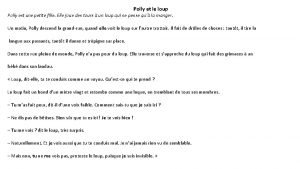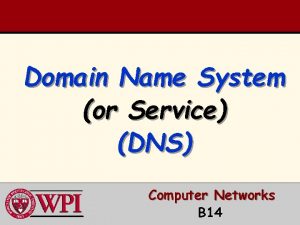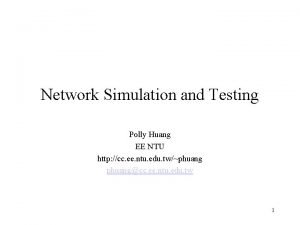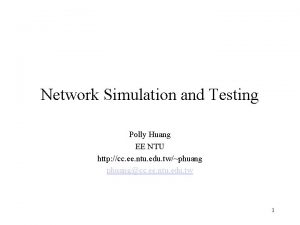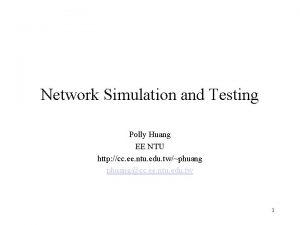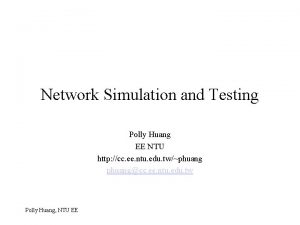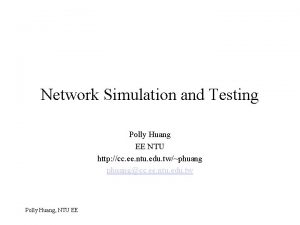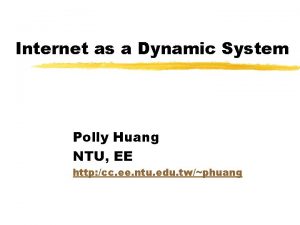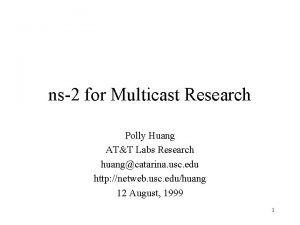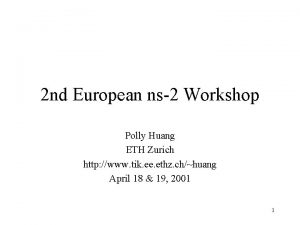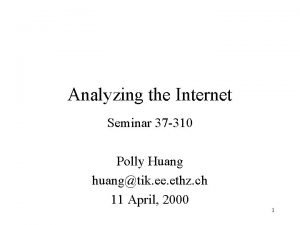Introduction to Computer Networks Polly Huang EE NTU







![struct sockaddr { unsigned short sa_family; // address family, AF_xxx char sa_data[14]; // 14 struct sockaddr { unsigned short sa_family; // address family, AF_xxx char sa_data[14]; // 14](https://slidetodoc.com/presentation_image_h2/9e613c7a4b66f9ef60a7d9534b76a262/image-8.jpg)

























- Slides: 33

Introduction to Computer Networks Polly Huang EE NTU http: //cc. ee. ntu. edu. tw/~phuang@cc. ee. ntu. edu. tw Polly Huang, NTU EE

Unix Network Programming The socket struct and data handling System calls Based on Beej's Guide to Network Programming Polly Huang, NTU EE

The Unix Socket • A file descriptor really • The Unix fact – When Unix programs do any sort of I/O, they do it by reading or writing to a file descriptor – A file descriptor is simply an integer associated with an open file Polly Huang, NTU EE 3

A File Descriptor • A file in Unix can be – A network connection – A FIFO queue – A pipe – A terminal – A real on-the-disk file – Or just about anything else Polly Huang, NTU EE 4

Jeez, everything in Unix is a file! Polly Huang, NTU EE

Well, we know how to handle files! • In theory – The read() and write() calls allows to communicate through a socket • In practice – The send() and recv() offer much greater control over your data transmission Polly Huang, NTU EE 6

The structs • int – For the file descriptor • struct sockaddr – Space holder for “types” of addresses • struct sockaddr_in – Specific for the “Internet” type – _in for Internet • struct in_addr – 4 byte IP address Polly Huang, NTU EE 7
![struct sockaddr unsigned short safamily address family AFxxx char sadata14 14 struct sockaddr { unsigned short sa_family; // address family, AF_xxx char sa_data[14]; // 14](https://slidetodoc.com/presentation_image_h2/9e613c7a4b66f9ef60a7d9534b76a262/image-8.jpg)
struct sockaddr { unsigned short sa_family; // address family, AF_xxx char sa_data[14]; // 14 bytes of protocol address }; Polly Huang, NTU EE 8

struct sockaddr_in { short int sin_family; // Address family unsigned, AF_INET short int sin_port; // Port number, in network byte order struct in_addr sin_addr; // Internet address, in network byte order unsigned char sin_zero[8]; // Same size as struct sockaddr }; Polly Huang, NTU EE 9

Struct in_addr struct in_addr { // Internet address (a structure for historical reasons) unsigned long s_addr; // that's a 32 -bit long, or 4 bytes }; Polly Huang, NTU EE 10

Reference • Let ina be of type struct sockaddr_in • ina. sin_addr. s_addr references the 4 -byte IP address in network byte order Polly Huang, NTU EE 11

Types of Byte Ordering • Network Byte Order – Most significant byte first – Need conversion from the app program to the network • Host Byte Order – Least significant byte first – Usually no need in app program – But need conversion if data coming from the network Polly Huang, NTU EE 12

Functions to Convert • htons() – Host to Network Short • htonl() – Host to Network Long • ntohs() – Network to Host Short • ntohl() – Network to Host Long Polly Huang, NTU EE 13

Storing the IP address ina. sin_addr. s_addr = inet_addr("10. 12. 110. 57”); • Returns “– 1” on error • For unsigned short it’s 255 • A broadcast address Polly Huang, NTU EE 14

A Cleaner Interface • #include <sys/socket. h> • #include <netinet/in. h> • #include <arpa/inet. h> • int inet_aton(const char *cp, struct in_addr *inp); Polly Huang, NTU EE 15

An Example struct sockaddr_in my_addr; my_addr. sin_family = AF_INET; // host byte order my_addr. sin_port = htons(MYPORT); // short, network byte order inet_aton("10. 12. 110. 57", &(my_addr. sin_addr)); memset(&(my_addr. sin_zero), '�', 8); // zero the rest of the struct Polly Huang, NTU EE 16

Things to Note • inet_addr() and inet_aton() both convert IP addresses into the network byte order • Not all platforms implement inet_aton() Polly Huang, NTU EE 17

Get the IP Address Back • printf("%s", inet_ntoa(ina. sin_addr)); • inet_ntoa() returns a pointer to a char* • And… Polly Huang, NTU EE 18

Use strcpy() char *a 1, *a 2; . . a 1 = inet_ntoa(ina 1. sin_addr); // this is 192. 168. 4. 14 a 2 = inet_ntoa(ina 2. sin_addr); // this is 10. 12. 110. 57 printf("address 1: %sn", a 1); printf("address 2: %sn", a 2); This program will print: address 1: 10. 12. 110. 57 address 2: 10. 12. 110. 57 Polly Huang, NTU EE 19

System Calls Polly Huang, NTU EE

socket() Creating the File Descriptor #include <sys/types. h> #include <sys/socket. h> int socket(int domain, int type, int protocol); domain: AF_INET type: SOCK_STREAM or SOCK_DGRAM protocol: 0 or getprotobyname() Polly Huang, NTU EE 21

bind() Associating Port with the FD • #include <sys/types. h> • #include <sys/socket. h> • int bind(int sockfd, struct sockaddr *my_addr, int addrlen); Polly Huang, NTU EE 22

Example (Typical Server) #include <string. h> #include <sys/types. h> #include <sys/socket. h> #include <netinet/in. h> #define MYPORT 3490 main() { int sockfd; struct sockaddr_in my_addr; sockfd = socket(AF_INET, SOCK_STREAM, 0); // do some error checking! my_addr. sin_family = AF_INET; // host byte order my_addr. sin_port = htons(MYPORT); // short, network byte order my_addr. sin_addr. s_addr = inet_addr("10. 12. 110. 57"); memset(&(my_addr. sin_zero), '�', 8); // zero the rest of the struct // don't forget your error checking for bind(): bind(sockfd, (struct sockaddr *)&my_addr, sizeof(struct sockaddr)); . . . Polly Huang, NTU EE 23

connect() Making a Connection • #include <sys/types. h> • #include <sys/socket. h> • int connect(int sockfd, struct sockaddr *serv_addr, int addrlen); Polly Huang, NTU EE 24

Example (Typical Client) #include <string. h> #include <sys/types. h> #include <sys/socket. h> #include <netinet/in. h> #define DEST_IP "10. 12. 110. 57" #define DEST_PORT 23 main() { int sockfd; struct sockaddr_in dest_addr; // will hold the destination addr sockfd = socket(AF_INET, SOCK_STREAM, 0); // do some error checking! dest_addr. sin_family = AF_INET; // host byte order dest_addr. sin_port = htons(DEST_PORT); // short, network byte order dest_addr. sin_addr. s_addr = inet_addr(DEST_IP); memset(&(dest_addr. sin_zero), '�', 8); // zero the rest of the struct // don't forget to error check the connect()! connect(sockfd, (struct sockaddr *)&dest_addr, sizeof(struct sockaddr)); . . . Polly Huang, NTU EE 25

listen() Waiting for Connection #include <sys/socket. h> int listen(int sockfd, int backlog); On the server side, you see typically this: socket(); bind(); listen(); /* accept() goes here */ Polly Huang, NTU EE 26

accept() Getting a Connection #include <sys/socket. h> int accept(int sockfd, void *addr, int *addrlen); Polly Huang, NTU EE 27

The Server Example #include <string. h> #include <sys/types. h> #include <sys/socket. h> #include <netinet/in. h> #define MYPORT 3490 // the port users will be connecting to #define BACKLOG 10 // how many pending connections queue will hold main() { int sockfd, new_fd; // listen on sock_fd, new connection on new_fd struct sockaddr_in my_addr; // my address information struct sockaddr_in their_addr; // connector's address information int sin_size; sockfd = socket(AF_INET, SOCK_STREAM, 0); // do some error checking! my_addr. sin_family = AF_INET; // host byte order my_addr. sin_port = htons(MYPORT); // short, network byte order my_addr. sin_addr. s_addr = INADDR_ANY; // auto-fill with my IP memset(&(my_addr. sin_zero), '�', 8); // zero the rest of the struct // don't forget your error checking for these calls: bind(sockfd, (struct sockaddr *)&my_addr, sizeof(struct sockaddr)); listen(sockfd, BACKLOG); sin_size = sizeof(struct sockaddr_in); new_fd = accept(sockfd, (struct sockaddr *)&their_addr, &sin_size); . . . Polly Huang, NTU EE 28

send() and recv() Data Transmission int send(int sockfd, const void *msg, int len, int flags); int recv(int sockfd, void *buf, int len, unsigned int flags); Polly Huang, NTU EE 29

Example char *msg = “Hello World!"; int len, bytes_sent; . . len = strlen(msg); bytes_sent = send(sockfd, msg, len, 0); . . . Polly Huang, NTU EE 30

sendto() and recvfrom() Transmission the Datagram Style int sendto(int sockfd, const void *msg, int len, unsigned int flags, const struct sockaddr *to, int tolen); int recvfrom(int sockfd, void *buf, int len, unsigned int flags, struct sockaddr *from, int *fromlen); Or if transmitting over TCP socket, one can simply use send() and recv(). Polly Huang, NTU EE 31

close() and shutdown() Closing the Communication close(sockfd); int shutdown(int sockfd, int how); • 0 -- Further receives are disallowed • 1 -- Further sends are disallowed • 2 -- Further sends and receives are disallowed (like close()) Polly Huang, NTU EE 32

Reference • Beej's Guide to Network Programming – http: //www. ecst. csuchico. edu/~beej/guide/net/ • Additional system calls • TCP stream client, server example • UDP datagram example Polly Huang, NTU EE 33
 Datagram switching and virtual circuit switching
Datagram switching and virtual circuit switching Basestore iptv
Basestore iptv Pollycop
Pollycop Lisa rowe monologue
Lisa rowe monologue Polly et le loup
Polly et le loup Brave new world summary chapter 1-3
Brave new world summary chapter 1-3 3 strikes law
3 strikes law Polly pereira
Polly pereira Chris polly fermilab
Chris polly fermilab Sister knight
Sister knight Polly chiu
Polly chiu Toma ime
Toma ime Polly peters positively played ping pong
Polly peters positively played ping pong Crc in computer networks
Crc in computer networks Crc in computer networks
Crc in computer networks Traffic management in computer networks
Traffic management in computer networks Speed of a computer
Speed of a computer What is optimality principle in computer networks
What is optimality principle in computer networks Snmp osi model
Snmp osi model What is optimality principle in computer networks
What is optimality principle in computer networks Uses of computer network in business application
Uses of computer network in business application Definition of computer
Definition of computer Dns in computer networks
Dns in computer networks Diffserv vs intserv
Diffserv vs intserv Icmp in computer networks
Icmp in computer networks Web and http in computer networks
Web and http in computer networks Framing in computer network
Framing in computer network Dns in computer networks
Dns in computer networks Data communication assignment questions
Data communication assignment questions Distributed systems vs computer networks
Distributed systems vs computer networks Badrinath
Badrinath Error detection and correction in computer networks
Error detection and correction in computer networks Error detection in computer networks
Error detection in computer networks Internet transport protocol in computer networks
Internet transport protocol in computer networks




